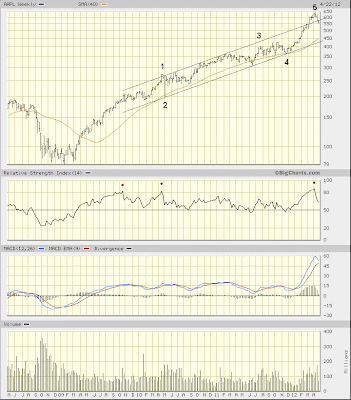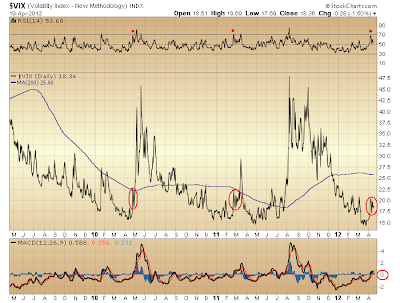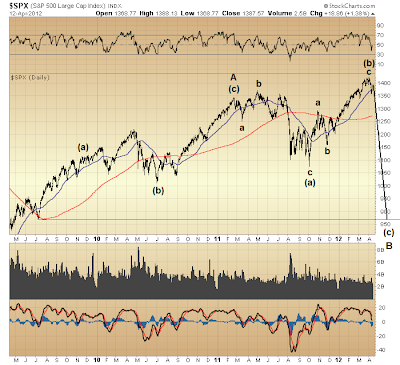Brought to light
here on Thursday was a view forward suggesting the market's counter-trend rally off March '09 bottom still could have legs. Now, this is not the first time such a prospect has been raised. However, being more inclined of late to regard underlying technical weakness as prospectively presaging an imminent collapse sinking major indexes to levels last seen in the 1987-1994 period, the one specific, previously discussed alternate possibility (raised once again on Thursday) was relegated to the back burner. There now is good reason to move it to the front.
As I said on Thursday, banks and financials are pointing toward this prospective view keeping alive the market's counter-trend rally since March '09. Again, my suspicion on this account is raised strictly from a technical perspective grounded in the Elliott Wave Principle. From this perspective we might assume the means to "extend and pretend" the worth of "assets" on bank books probably is available (meaning there might be something to David Goldman's "negotiation"). Captive lenders of last resort might be better assumed to have not yet emptied their collective bag of tricks. Not that any of it will bring anything that is, even now, already long passed its "best if used by" date. There isn't a trick remaining that can abate hyperinflationary breakdown of the physical economy. Yet controlling this effect some time longer seems a reasonable enough possibility. Supporting this likelihood is the following, prospective Elliott wave view applied to financials...
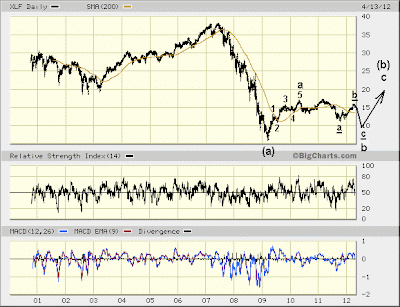
The simple matter of a prospective five waves up from March '09 through April 2010 beckons consideration of a view supposing formation of but wave
a of an a-b-c counter-trend rally following $XLF's 2007-2008 bloodletting. Wave
b forming since is developing similarly to other major indexes (yet in $XLF this middle corrective wave began in April 2010, as opposed to February 2011 in $SPX).
Projected upcoming weakness — this slated to complete $XLF wave
b — is a risk founded on technical evidence accruing over the past six months, the likes of which has been detailed here to no end, while nothing subsequently developing over the interim negated the essence of those several foreboding conclusions arrived at along the way.
Anticipated, upcoming weakness notwithstanding, though, March '09 $XLF bottom must hold, otherwise the Elliott wave count indicated above will be invalid.So, $XLF's five wave lift off March '09 bottom opens the way for assuming still further development of a counter-trend rally whose unfolding in fact but began with those five waves up. Longstanding technical weakness now gives objective form to the prospective dimension of upcoming selling simply as a consequence of the necessity that, March '09 $XLF bottom
must not be violated for there to be any hope that, the stock market might maintain its levitated state for some months and, indeed, years yet to come. With basis $XLF provides for assuming this possibility, then, let's turn to this same prospect applied to the S&P 500...

The Elliott wave count applied to $SPX above assigns its labels a bit differently than has been done here previously. The context of this proposed, alternative wave count will be clear in the following monthly chart of the S&P 500 dating back to 1970. Although the above wave count differs from views presented in the past, the essence of the S&P 500's rally off March '09 bottom remains unchanged: it is counter-trend; a corrective wave within a larger decline.
As an aside, the $XLF:$SPX relative performance contrast since Y2k appears a restatement of an ages old lesson regarding the use of leverage: joy is greater when leverage can be furthered, but when it can't, the awful consequences are all the more magnified to the depths of its user's dread.
Might this relative contrast, too, though, particularly since March '09 bottom, offer prospective insight into considerable weakness still likely to develop going into this summer? $XLF already has tested its early-July 2009 interim low (which low ended wave
2 of
a). This same level could be the upcoming objective $SPX likewise soon retests (as
indicated on Thursday, and further substantiated below). Could $XLF be at considerable risk, then, of imminently challenging its March '09 low were $SPX to slide upward of 40% going into this summer? Possibly. Yet then again, maybe time has come for a notable divergence to presage subsequent continuation of the market's counter-trend rally off March '09 bottom. Maybe the "
Recipe for Fraud" that has been called the recently passed "
JOBS Act" is precisely what financials need to get back on track, at least for a few years more, anyway.
Further perspective on the above Elliott wave count applied to the S&P 500 is provided below on the index's monthly chart...

This chart of the S&P 500 was presented here in late-2009 (sans the Elliott wave count). What's "new" is my "certainty" that, five waves up from 1974 - 2000 form in the S&P 500 the fifth wave of five waves up from 1932, while five waves up from 1932 form but the third wave of a larger, five wave advance whose beginning is thought to date back at least to the Civil War (1861-1865) or quite possibly earlier. The green lines drawn approximate the price channel in which wave
V of
(III) traversed during its more than twenty-five years of development.
The red line drawn is an interesting curiosity revealing a dynamic line of support-resistance existing over the entire duration of the S&P 500's gyrations charted above. Although I will forego qualifying this line's relevance in the context of the S&P 500's Elliott wave count since 1970, suffice it that from here forward, until the market's eventual collapse, this line likely will cap the S&P 500's advance, both over the next month, as well as over coming years, during which interval wave
B of
(IV) is slated to complete. Much as we are seeing an abundance of long-developing, underlying technical weakness coinciding with the S&P 500's present test of this dynamic line of resistance (an approximation of this line was drawn on $SPX's daily chart above), we probably can expect the same, widespread demonstration of underlying technical weakness again — indeed, all future indications might be worse than those today — when wave
(c) of
B nears its end, an event likely to occur in the latter half of the decade. Indeed, I am rather confident this line of resistance will remain intact given today's macro state of affairs wherein leverage once good for the market clearly has turned into a terribly vexing negative.
As for the upcoming completion of wave
(b) of
B — this projected to culminate in a steep sell-off sinking the S&P 500 to the vicinity of 875 going into this summer — another curiosity appears on the above chart. The gray line I have drawn approximates the S&P 500's steepest trend line since 1974 bottom. Coincidentally enough, a drop to this trend line would sink the S&P 500 to the vicinity of 875. Given deteriorating conditions among the larger countries in the euro-zone periphery there is fundamental reason to suspect this [rising] trend line might soon be tested, not to mention an abundance of well-established technical evidence likewise warning the same.
The question I have right now pertains to the character of wave
(c) of
B [higher] whose unfolding subsequent to the market's upcoming gassing might extend over several years. We might find its early development a fairly choppy affair, much like that from 2004 to mid-2006.
Not yet mentioned are cyclical factors likewise supporting both the near-term and longer outlook developed here. Although cyclical considerations more so serve as guideposts in my analysis than strict determinants of projected price action, the several cyclical measures I have long kept an eye on all substantiate the prospective path forward laid out here. Thus, too, the market collapse I have been anticipating over the past couple years likewise finds cyclical basis for suspecting such an event might be delayed until the 2018-2021 period.
* * * * *
© The Risk Averse Alert — Advocating a patient, disciplined approach to stock market investing. Overriding objective is limiting financial risk. Minimizing investment capital loss is a priority.
Analysis centers on the stock market's path of least resistance. Long-term, this drives a simple strategy for safely investing a 401(k) for maximum profit. Intermediate-term, investing with stock index tracking-ETFs (both their long and short varieties) is advanced. Short-term, stock index options occasionally offer extraordinary profit opportunities when the stock market is moving along its projected path.
Nothing is set in stone. Nor is the stock market's path of least resistance always known. More often than not, there are no stock index option positions recommended. There's an easy way to boost your investment discipline...
There's an easy way to boost your investment discipline...
Get Real-Time Trade Notification!
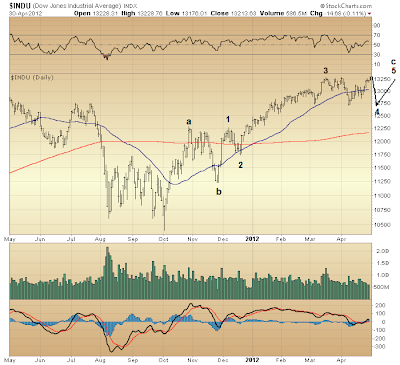

 There's an easy way to boost your investment discipline...
There's an easy way to boost your investment discipline...




